Rudy Rucker's Blog, page 47
October 10, 2011
Journal Excerpt: Thoughts on the Artist's Alienation.
As I mentioned in an earlier post, I'm combining and polishing my collected journals for the twenty-one year period 1990 to 2011. I might publish them in some form next year, perhaps only as print-on-demand and as e-book. It'll be two volumes, one 1990-2002, the other 2002-2011. Here's a cool passage that I happened to be editing today. Today's illos are recent ones, from Los Gatos, Santa Cruz, and Ardenwood Farm.
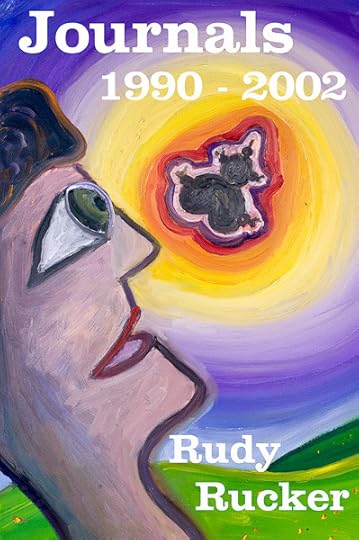
It's early April, 2002, and I'm in Torino, Italy, to give some kind of talk. I'm now sitting on my bed in the City Hotel in Torino. The sound of opera singing from across the hall is very loud, I guess it's on their radio? Or maybe it's some live person or persons rehearsing opera? Bellowing. Cute, in a way. Just the thing to remind me I'm in Italy.
I go outside and do my my initial Mars Rover number, trundling around the streets. It's cold and raining. The streets are so Italian. It's so wonderful, so amazing that this parallel un-iverse is now and ever ongoing, and that all I have to do is to get in a plane and take a lengthy but not really all that difficult eighteen hour journey to access this plane of existence.
[image error]
I see a nice café on a side street full of women in pairs and threes and fours, sitting at tables drinking coffee and eating pastries, all of them talking to each other, all of them using their hands to talk, and the quick visual effect of looking in through the tinted glass was of a tide pool of anemones with their tendrils waving.
Now it's 2 am and I'm having this jet-lag insomnia Camper Van Beethoven Eyes of Fatima interlude.
"Take the hands off the clock—you're gonna be here for a whiiiiile."
(Camper Van plays this with warpy, snit-snit, down-the-wormhole bad-acid guitar licks in the background, you understand.)
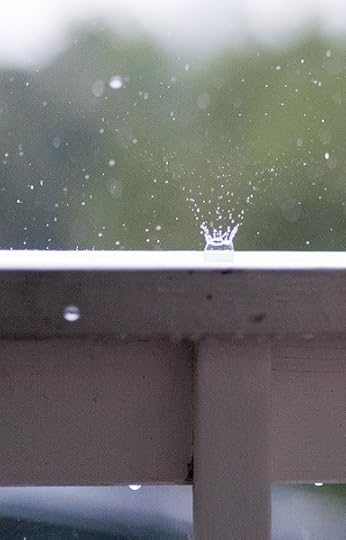
I open the door to the night balcony and it's raining outside. I've been looking forward to this moment. There's nothing like jet-lag when you're traveling alone and you can turn the light on and fire up the lap-top, my drug of choice these days.
So now I'll work on my current novel. Or maybe on a journal entry.
What if I didn't have my books to define myself by? It would be tough—to just live in the light of day and not to have my daily scene lit by the footlights of the literary stage. It would mean going back to life at degree zero, like my life was when I was a young Nobody from Nowhere.
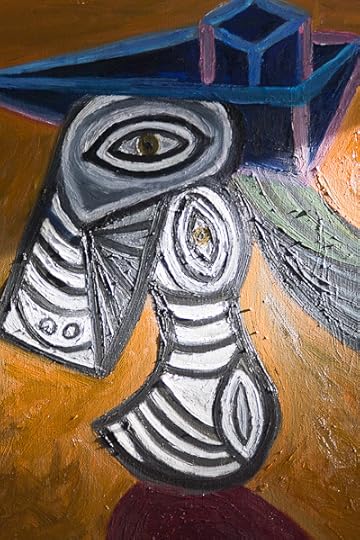
Yet even back then I had my portable footlight with me, its generator pooting along. What fuel was the footlight generator running on back then? Irony, viewing things at a remove. Drink-ing or getting high used to help with that. My concomitant physical malaise acted as objective correlatives for an artist's neurasthenic alienation.
An artist feels emotionally different from his or her fellows. But, just to deconstruct that old trope—from listening to people talk about themselves over the years, I've found that most people feel different from others. Even the seemingly bland dummies are alienated, it's just that the bland dummies don't have the talent for making a geschrei about it. A raucous tumult.
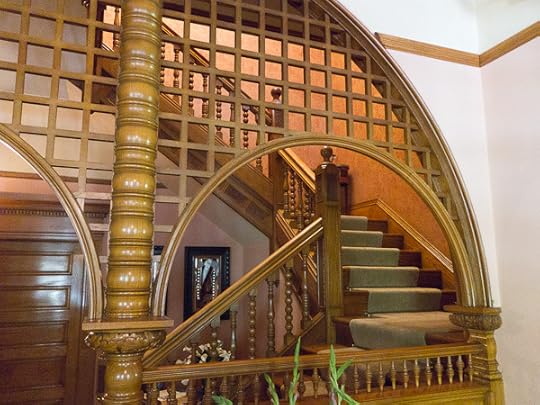
And, second deconstruction, it is occasionally possible to be, or at least to feign to be, a Whitmanesque yea-saying artist who fully embraces the daily things, like Jack K. going, "Wow, what great apple pie! With ice-cream on it! Yes!"
I had a little moment of that joy-with-the-given at the San Francisco airport, simply enjoy-ing the architecture, the awesome height of the vaulted hall, the light glancing off the shiny stone floors and rendering everything in shades of greenish gray, and us travelers scattered about like the stylized figures in a maquette.
And I got another hit of that while changing planes in Amsterdam, simply looking out at the friggin' light poles around the airfield, enjoying how they were grouped. And here and now, for that matter, I take a simple, non-alienated joy in being awake alone at night in Italy, with the sound of rain outside, at the leading edge of spring, me here with my fingers and my words and my hard-drive, sketching, sketching, sketching.

"What a sweet thing is perspective," as Paolo Ucello used to say.
Ding dong goes the elevator, bringing my opera-singing neighbors back to their room. 3 am. I'm gonna be here for awhile.
September 30, 2011
4D Ducks. Ideas for Strange Games.
A new painting today. Four-dimensional Ducks. I started with an abstract painting with seven globs. I made efforts to make the globs look different from each other, and to have intricate, three-dimensional forms.
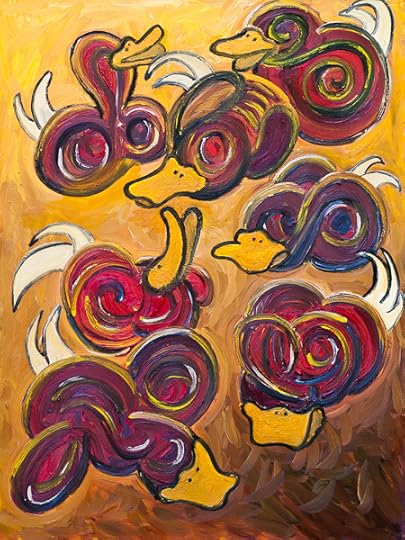
"Four-dimensional Ducks," by Rudy Rucker, 30 x 40 inches, October, 2011, Oil on canvas. Click for a larger version of the picture.
And then I started thinking of the globs as cross-sections of four-dimensional creatures. And then I realized they should be Carl Barks ducks, rotating in and out of our space. Four-dimensional ducks. I may yet tweak this painting a bit more.
As always, you can find more info on my art at my Paintings page.

I've been editing a volume of my electronic journals that runs from 1990 – 2002. Interest-ing and nostalgic. So many things have sunk into my deep memory, but, now, when jogged, they come back up. Nice to be editing these hundreds of thousands of words, and in some sense improving my past. Eventually I'll publish some volumes of journals in small press and/or as ebook.
Here's six game ideas from 2001 I came across today, some a bit stale, some still unused…
(1) Cellular automata. A surfing game with non-linear continuous-valued cellular automata to emulate the waves. Stanislaw Ulam worked on continuous-valued CAs for simulating partial differential equations. See my CAPOW program for surfable CAs.
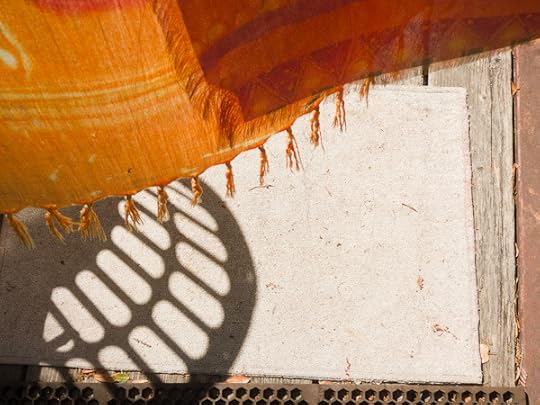
(2) Artificial life. We haven't pushed hard enough on having the phenome, or body shape, mirror the genome, or parameter strings. That is, the appearance the creature should directly emerge from the parameter-string "genes" that your program is evolving. I was trying to do this with my old Boppers program.
(3) Chaos. Chaotic motion is the most beautiful. You can easily get it by hav-ing a few counter-acting forces, such as 3D pendulum with a few virtual magnets. Forget about pre-programmed motion paths and let your game characters move chaotically. Trust the gnarl. See for instance, the Magnets module of the Autodesk Chaos program.
(4) The Fourth Dimension. It's time for more four-dimensional games. After all, Doom was like a 3D version of the old 2D game Pac-man. Let's go up another level. A 4D maze of tunnels. And the lovely, higher-dimensional polyhedra—and the globby cross-sections of hyperspace beings.

(5) Fractals. Simple idea: hide a gem in the Mandelbrot set let the game player look for it. Zoom into the right spot—are you hot or cold. Interesting scenery on the way. Would be even more interesting to work with a 3D version of the Mandelbrot set, with the 4D Cubic Connectedness Map, or with other far-out variations. Way gnarly.
(6) Space curves. I once spent some time working on smooth and twisty "kappa-tau" space curves defined in terms of smoothly varying curvature and torsion parameters. The goal is to have virtual reality with real-feeling flight. This hasn't been nailed yet. I want to fly, and I've never been able to do it except in dreams. The right way to fly might be to use curvature and torsion. Your controls adjust these parameters, rather than the mere direction of flight. That could be how actual birds do it. Also consider Craig Reynolds's still-unsurpassed Boids as an approach to flight simulation. Swooping in a wheeling flock.
September 23, 2011
Making Your Own Ebooks
This is one of those posts where I describe something obscenely complex that I did with my computer. The reason I want to post it is so I can find the description after I've totally forgotten the details in six months. Computer knowledge has such a short half-life.
As I often do, I'll be using photo illos with absolutely no connection to the subject at hand. I took these photos at Nick Herbert's house in Boulder Creek, on a dude ranch in Wyoming, and in the park at Wilder Ranch in Santa Cruz.

Tools
So suppose I have a document and I want to make it into a EPUB-formatted ebook.
Tools I'm going to mention: Microsoft Word, Adobe Dreamweaver, the free Calibre ebook software, the free Sigil epub software, and the free Epubcheck software.
Certainly you can use text editors other than Word. But I own a copy and am very accustomed to it. Again, I use Dreamweaver because I happen to own a copy. I'm not knowledgeable enough to recommend others, probably there are some decent free ones out there.
For a DOC with no images, you save the DOC as an RTF then go direct from RTF to EPUB with Calibre, and then tweak the resulting EPUB with Sigil.
For purposes of EPUB conversion of a DOC with images, I need to use a more complicated workflow.
For files with images, I convert from Word DOC to HTML to EPUB, using Dreamweaver to get from DOC to HTML and using Sigil to get from HTML to EPUB. Calibre doesn't come into the picture here.
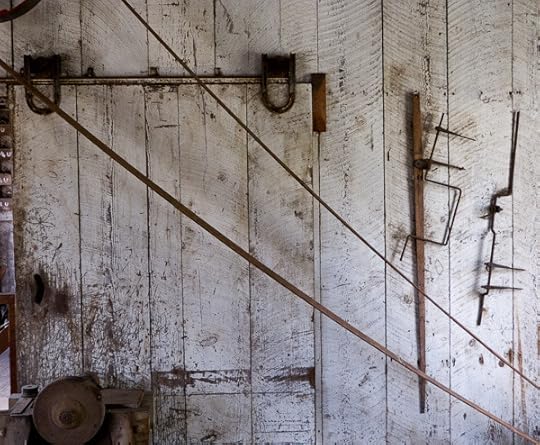
Setup
I make a directory for my project and put my Word document in there. It's important at this point to format all of your chapter or section headings with a Header style such as Header 1, Header 2, etc. The EPUB file is going to want to make a table of contents, and it will build them by finding Header-formatted lines.
Regarding the images you want to include, even if you inserted them into your Word DOC from somewhere else on your hard drive, put copies of all the images that in a subdirectory of your project directory and name the subdirectory Images. Use some photo editing software to adjust the sizes of these images not to be more than, say, 800 pixels across, and you can even get by with 600 pixels.
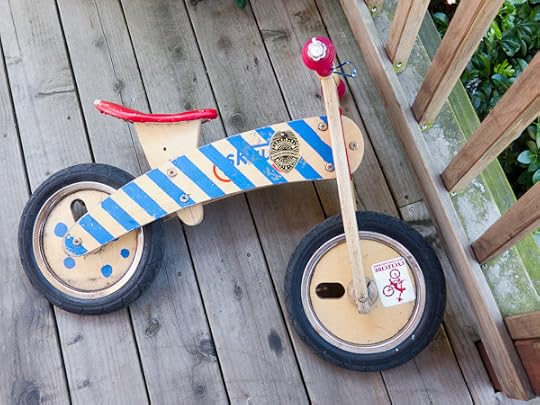
Converting DOC directly to EPUB
The free EPUB software Calibre will convert a DOC into an EPUB file very easily. It's kind of a no-brainer.
First save your DOC file into the non-proprietary RTF format. Word will do this. And of course any other word-processor will make RTF files as well.
Use the Add Books button in Calibre to add the RTF file. Then click the Convert Books button to convert to EPUB. The conversion process shows you a dialog box where you can fill in Title and Author, also you can get a cover image onto the clipboard and right click on the cover area to paste it in. And then a little symbol spins at the lower right of the screen for a minute or two. And then it's done.
You can click on the EPUB word beneath the name of your book to check it out. And you can save the EPUB wherever you want. Be sure to save your EPUB file with a name that has no spaces in it, or there may be trouble later on.
Downside: if your original DOC, and the RTF, had images in them, the images probably aren't going to be present in your Calibre-made EPUB.
Even you don't have images, there probably will be some catches and error messages if you try and distribute this quick and easy EPUB, like to your iPhone. Generally you need to load the EPUB from Calibre into Sigil to do some tweaks, such as fixing the table of contents and set-ting the Title, Author, and Language fields. Jump down to the "Tweaking in Sigil" section below.

Converting DOC to HTML
Usually I turn Word documents into HTML by opening the Word doc, selecting everything in it, copying that to the clipboard, and pasting the clipboard contents into the Design area of an empty HTML file in Dreamweaver.
If I have a lot of images in my document, this isn't a good approach—because Dreamweaver will make crummy little clip-art copies of the images that are linked into the document. I'd like to have more control over my images.
So, still in Word, I save the Word file as a "filtered HTML" file. Filtered means there's less Word crap in the file. And I open this file in Dreamweaver and use Commands | Clean Up Word HTML… to get rid of more Word crap. When I save the "Filtered HTML" file, Word makes a directory of extra files in my directory, but there's actually nothing in that directory that matters, and you can delete it.
Either way, I've now got an HTML of the file that I want to make into an EPUB.

Tweaking the HTML.
While you're in HTML, look at the image links, and make sure they all point to file-names to the Images subdirectory that you made. You may need to use the Edit | Find and Replace dialog to get things set.
It's better not have the size of the images hardcoded. That way you're free to force in larger images if you want. Use the Edit | Find and Replace dialog and for the Search: field select Specific Tag and set to img, then for the Action: field select Remove Attribute and set to width. Then do the same for height. Then do the same for border.
Fill in the Title field for your HTML. Delete the body attributes link and vlink, but if you don't, you can later get rid of these in Sigil.
Don't use any font larger than about 18 points for titles or sections, or it'll look too big on a smartphone.
It's nice to have separators between your sections. Up at the top of your HTML file, inside the style block of definitions, add this line
hr {page-break-after:always;}
And then, wherever you want a break in your document, insert the symbol < then the letters hr then the symbol >, and you get a nice looking line like below, which plays the role of a page break. I can't write out what you actually put, because then you just get the pagebreak line!
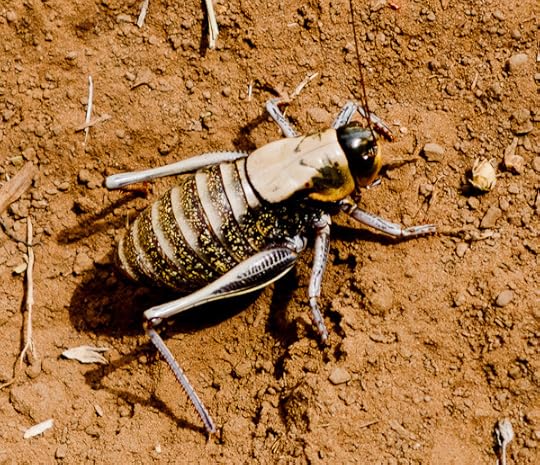
Tweaking HTML and EPUB in Sigil
So now you've made an HTML file with Dreamweaver or perhaps you've made an EPUB file with Calibre. Open the HTML or EPUB file in Sigil. As soon as you open you file in Sigil, it's converted into an EPUB file that you can save and distribute. But first do some tweaks.
Use the menu item View to put check marks on Book Browser and Table of Contents.
The Book Browser shows all the different components that are hidden inside your EPUB file.
The Table of Contents window should show a Table of Contents. You can create a Table of Con-tents by clicking Generate TOC from Headings, and then clicking OK in the Heading Selector. You can see if it worked by double clicking on some of the items in the Table of Contents box.
Use the menu item Tools|MetaEditor… to fill in names for the Title, Author, and Language of your EPUB file.
For the cover of your Ebook, use an external photo editor to create a cover.jpg file which is 612 pixels wide and 792 pixels high. It should include your name and the title of the book. Save it in somewhere in your project directory, perhaps in the Images subdirectory. In Sigil use Insert|Image to insert this image at the very start of your EPUB document.
In the Book Browser window in the left hand side of your Sigil window, find the Images directory and look for contents.jpg in there. Right click on it, select Add Semantics, and check Cover Image.
Now before you save and distribute your EPUB, use the Sigil Tools|Validate EPUB selec-tion to see if you get errors. If you click on the error messages, you'll see source code for the EPUB where you can try and correct the problem.
As with Calibre, be sure to save your EPUB file with a name with no spaces.
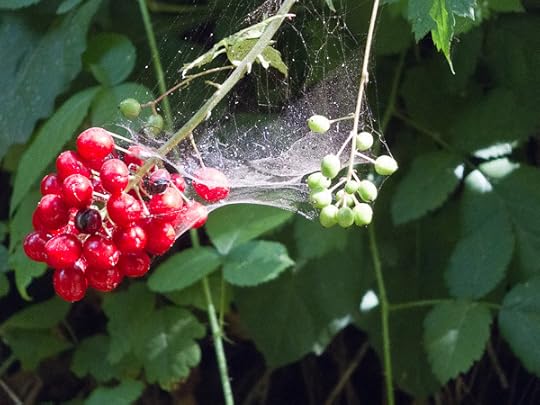
Validating with Epubcheck.
Install the Epubcheck ware on your computer, it probably ends up in Program Files\Epubcheck. Make a sample subdirectory of the Epubcheck directory and put a copy of your current EPUB file there. Suppose it's called betterworlds.epub.
Then go to the Command Line interface for your computer, navigate into the directory where epubcheck lives, like to Program Files\Epubcheck. Now run a command like this:
java -jar epubcheck-3.0b2.jar sample/betterworlds1.epub
Of course the letters and numbers after epubcheck depend on which version of the software you have. And the name of the epub file depends on what file you're checking.
If all goes well, epubcheck will either print a "No Errors Found" message, or it will spew out a lot of error messages. You can scroll up and down to see them all. Most common causes of errors are (1) you forgot to build a table of contents using the Sigil Table of Contents window, or (2) you didn't fill in the Name, Title and Language fields using Sigil Metatool, or (3) the Epub ware is confused because you gave your epub file a name with spaces in it. If you see an error you can't understand, try copying into the Google search bar to see what other people say about it.
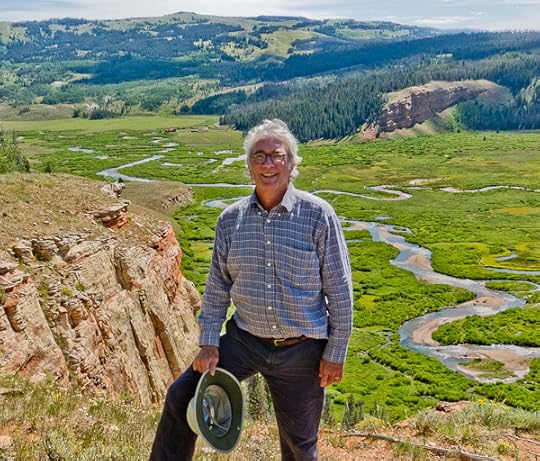
Publish on Lulu?
Once you've got your EPUB file looking pretty good, you can publish it online in some form or another. Right now, one of the easiest ways to do this is via Lulu, although eventually I may try and figure out how to start selling ebooks and print-on-demand books myself.
Check out my two newly made EPUB ebooks, $1.99 each on Lulu:
Rudy Rucker, Better Worlds (Ebook)
Terry Bisson and Rudy Rucker, Billy's Picture Book.
September 18, 2011
New Painting: "Rigging"
A new painting today.
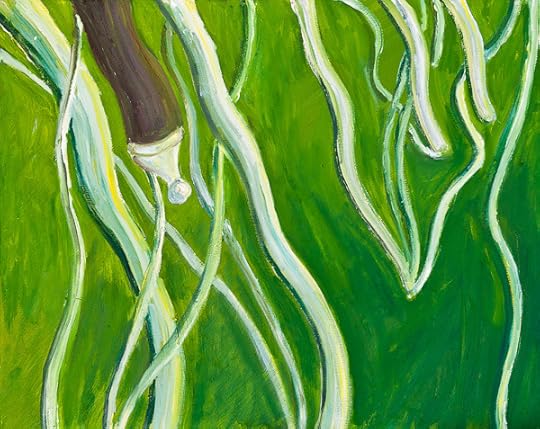
"Rigging," by Rudy Rucker, 20 x 16 inches, September, 2011, Oil on canvas." Click for a larger version of the picture.
The reflections of sailboat rigging fascinate me. I took some photos for this painting during the same session where I started Santa Cruz Harbor. Back home I copied one of the photos for this oil painting. I put on quite a few layers, and used a gel medium to emphasize the brush strokes on the masts and lines.
As usual, you can get prints or originals of my paintings at my paintings site.
I made a new edition of Better Worlds on Lulu, with all eighty-six of my paintings thus far.
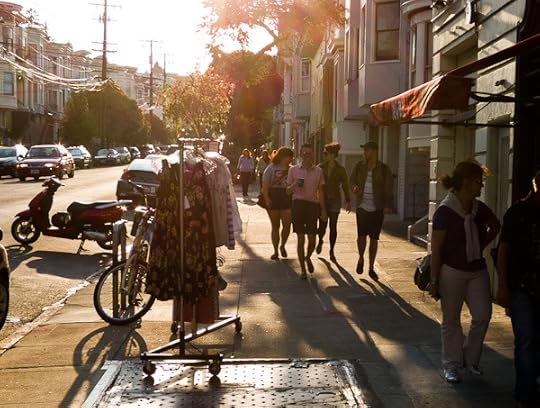
The eBook business is an ever-changing maze. I set up a page with information about links for getting eBook editions of my works. You'll notice a link to this page in the upper right corner of my blog. Feel free to suggest corrections via the comments on that page.
September 13, 2011
Trip to Wyoming
We spent four nights with daughter Isabel and her husband Gus at the Darwin Ranch, a 160 acre resort along the Gros Ventre River in the midst of the Bridger National Forest, between Pinedale and Jackson, Wyoming, not far from the Grand Tetons. "Grand Tetons" means "large breasts," and "Gros Ventre" means "plump belly." One thinks of lonely French explorers.
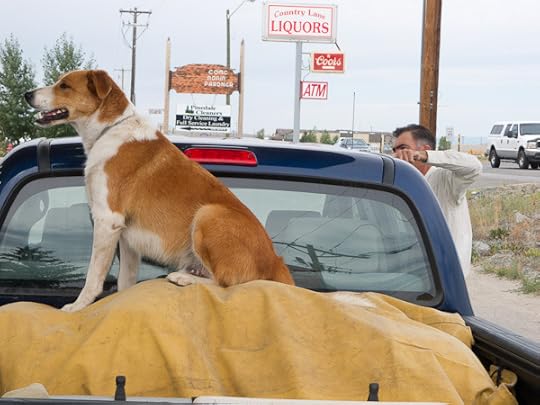
We dropped off dog Rivers and hit the road.

The Darwin Ranch has some fairly simple log cabins and a lodge house where the twenty guests met for cocktail hour, meals, and after-dinner hanging out.

It's located in a valley gouged out by the narrow and snaky Gros Ventre River—more of a creek than a river. Two sides of the valley are lined with sheer red bluffs. The upstream end of the valley slopes up into a forest with a waterfall.
A fabulous place—160 acres going up for auction at Hall and Hall realtors with a starting price of $4 million on September 13. In a way, it's a modest sum, the price of a McMansion in California!
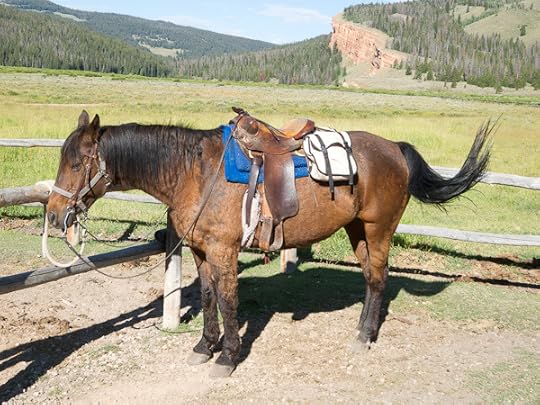
The ranch has about twenty horses for the guests to ride—it's a dude ranch, but in a fairly mellow way. The place has a bit of a hippie feel, even though all of the guests (other than our daughter and her husband) looked to be in their fifties, sixties or even seventies. That's the horse Alice that I rode one day up there.

As it happens the man who owns the Darwin Ranch is Loring Woodman, a cousin of my friend Howard Swann, a colorful and voluble mathematician with whom I worked at San Jose State. Howard and his wife Anita were at the ranch with us—it was good to have some comfortable old friends to chat with. Howard has an extravagant, playful style of speech. He goes for odd phrasings, recondite words, and unusual rhythms, sounding a bit like the W. C. Fields. That's a picture of Howard and me. One of Howard's proudest achievements is his cartoon-illustrated McSquared's Calculus Primer.
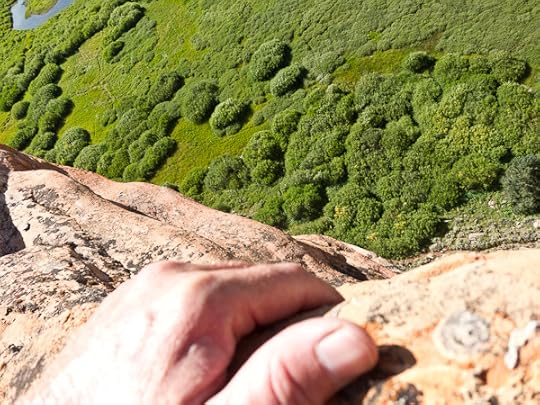
Isabel and Gus actually worked as the winter caretakers at the Darwin Ranch some years ago, and they've stopped by for visits a number of times over the years. It was a treat for them to be actual guests. On the first day we four hiked along the top of Sportsman's Ridge, a slanting red bluffs that bounds the north side of the valley.
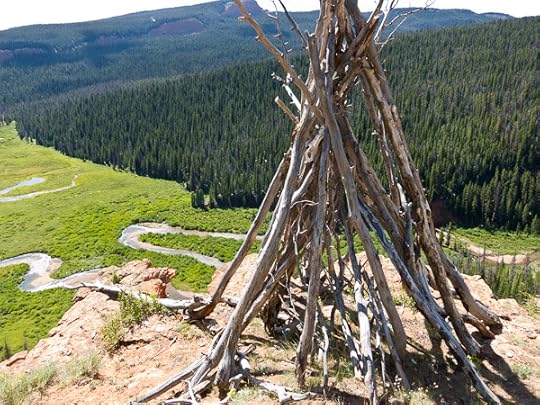
We had an amazing view of the Gros Ventre River's meanders across the valley, making a shape in every way like that of a rivulet of water you might see flowing down your car windshield.
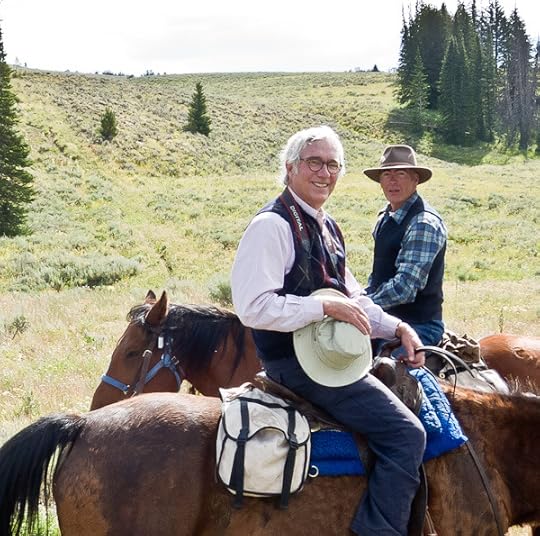
The second day I went on a four hour horse-riding expedition with Gus, Isabel, and Howard Swann. I'd never ridden a horse before, but the others coached me. My horse Alice was quite docile, and although not particularly interested in me as an individual. She carries riders several times a week.
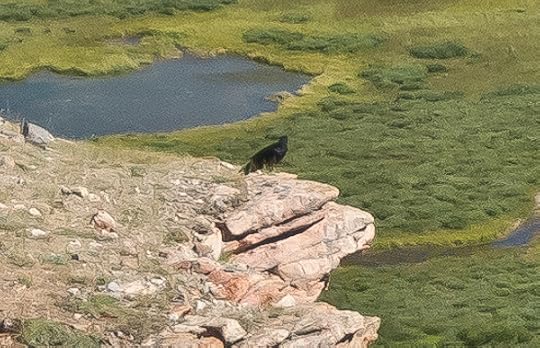
Heading up the two-thousand-foot rise to the top of Bacon Ridge, I noticed a large raven in a tree. I remembered a particular fairy-tale scene I loved when I was growing up. A boy is the helper of a wizard. They're travelling across the countryside, and the wizard manages to shoot a particular raven with his bow. The wizard tells the boy to build a fire and roast the raven's heart for him, giving the boy particular instructions that he mustn't taste the tiniest fragment of the heart until the wizard has had the first bite. The wizard lies down for a nap and the boy gets to work. The raven's heart sizzles over the flame, and piece of hot fat lands on they boy's finger, burning it.. The boy puts the finger to his mouth, licking it to soothe the pain. And in that instant he receives the magic power that lay in the raven's heart: he can understand the speech of birds and animals.
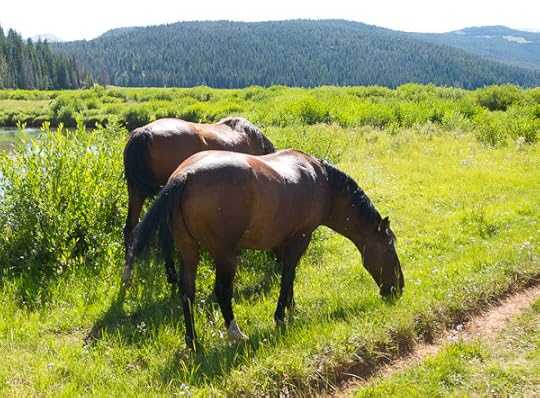
Somehow this episode has always held a special meaning for me. When my son Rudy was young, I'd discuss this story with him, and when we'd bring a roast holiday turkey to the table, we'd compete to tear off and devour a scrap of the golden skin and say to the other, "Now I understand the speech of birds and animals." Seeing the raven the Wyoming woods, I began thinking that I might use the old fairy-tale trope in a short story or in the start of a novel this fall.
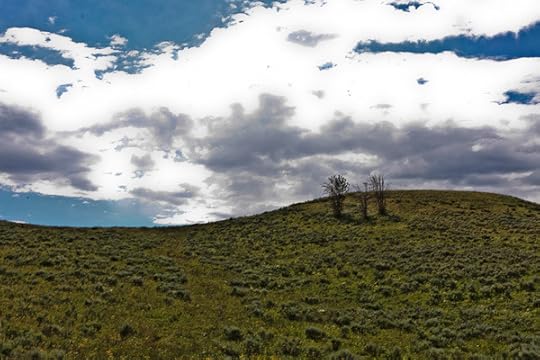
We rode up through pines and aspens, up through the late-summer-yellow fields, up to the bare windy peak of Bacon's Ridge. It felt like a once-in-a-lifetime adventure to me. Over and over my horse Alice would grab bites of the trail-side vegetation—she was particularly fond of a certain enormous thistle plant that fills a human's hand with prickers if touched. It wasn't all that hard to stay on the horse, although I was definitely clutching the saddle-horn at times, and bracing my feet against the stirrups—particularly on the way back downhill. The whole process of riding a saddle on a large animal felt very ancient, very highly evolved.

The third day on the ranch, Sylvia, Isabel and I hiked through the forest along the base of the Sportsman's Ridge bluffs while Gus went fly-fishing. Eventually we three reached Ouzel Falls, which is a very steeply slanting rapids rather than a proper waterfall—it's a bit like a hundred-yard water slide, seething with white foam. Some small diving birds called water ouzels frequent the pool at the falls' base, thus the name.
Before we'd set out on our hike, Loring had urged us to make a loop of the hike by clambering to the top of Sportsman's Ridge near Ouzel Falls and taking the high road home. Sylvia didn't want to add on the extra climbing, so Isabel walked back to the Ranch with her while I pressed on alone.
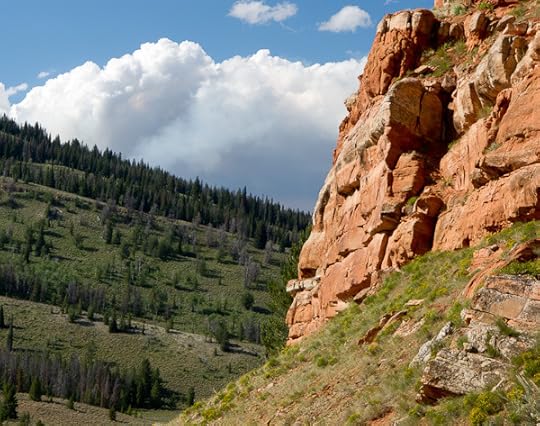
I was quite tired by now, in part due to the thin air at the eight or nine thousand foot altitude. I was hot, and my water supply was fairly low—even though Isabel had kindly given me the rest of her own water. Starting up the steep path alone, I was a little anxious that my heart or my brain might suddenly malfunction, leaving me to die alone in the wilderness. But I was determined to press on.
In the old days, I'd very often taken long and risky hikes alone. But I hadn't done a hike like that for something like five years—I think the last one was in August, 2006, in Glacier National Park.
I lost the trail twice in gullies, found it again both times, and after an hour I was up on the top of the bluff. The High Path. I felt wonderful. On top of the world. Just like old times.

It was a good feeling to have pushed past the fear and done something physically audacious once again. I felt more wholly well than I'd felt in quite some time. A wonderful day.

After Wyoming, I went on to Wisconsin to visit my other daughter Georgia, with her husband Gus and their children .
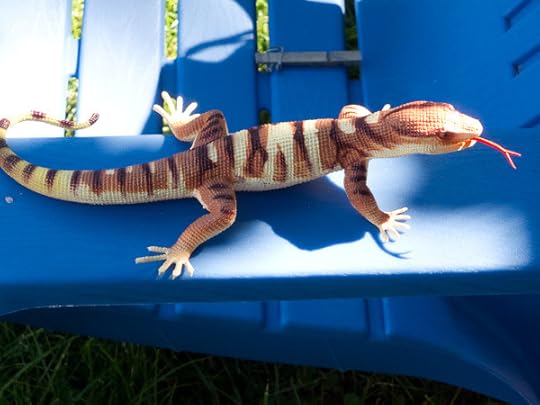
In the mornings, I often read my grandson his favorite (that week) book, Hogwash, no words, just lots of pix of little pigs wallowing and romping in mud and paint—and then being herded and washed by slightly sinister pig-mothers. My grandson is a cuddly bundle. He reminds me very much of the childhood photos of myself. I'm exceedingly fond of him and my Wisconsin granddaughter.
September 11, 2011
My Emperor Norton Award (Tachyon Party at Borderlands)
I was at Borderlands Books in SF for the annual Tachyon Publications party on Sunday from 2-4.
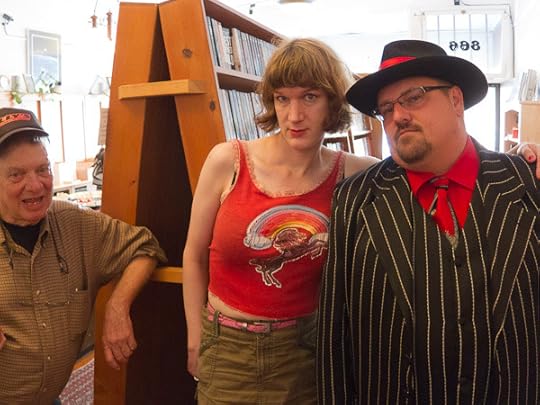
Among the assembled SFictional luminaries were my fellow-writer (and Kentuckian) Terry Bisson, Charlie Jane Anders a writer and impresario known for editing the SF site io9 running the Writers With Drinks salon, and Jeremy Lassen—my editor and publisher at Night Shade Books, dressed in a full-on zoot suit from Mission Street.
One of the events at the party is the awarding of two Emperor Norton Awards. As Locus magazine explains:
The Emperor Norton Awards are a San Francisco Bay area specific award given each year for "extraordinary invention and creativity unhindered by the constraints of paltry reason". The award is named after and commemorates the memory of Joshua Norton I, Emperor of the United States of America and Protector of Mexico, and are presented annually by Tachyon Publications and Borderlands Bookstore in San Francisco.

I was a proud recipient of one of the Norton Awards! It's nice to get an award now and then, very heart-warming. Along with me, the photo shows Jacob Weisman of Tachyon Books, Jude Feldman of Borderlands Books, and SF eminence grise Richard Lupoff.
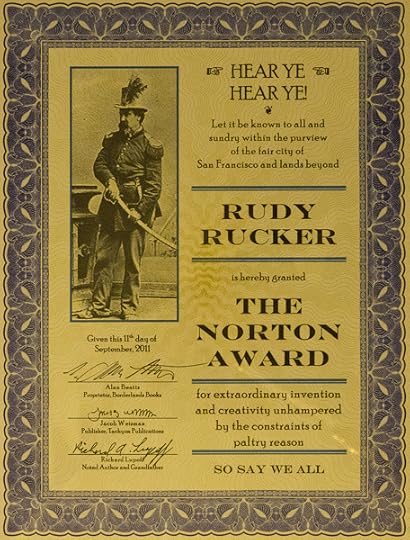
Here's a close-up of the finely printed certificate. Emperor Norton was known for printing his own money—which became an accepted local currency in 1870s San Francisco! Kind of like being a writer, really. We deal with funny paper.
It was a great day and a fun party. Many thanks to Tachyon and Borderlands.
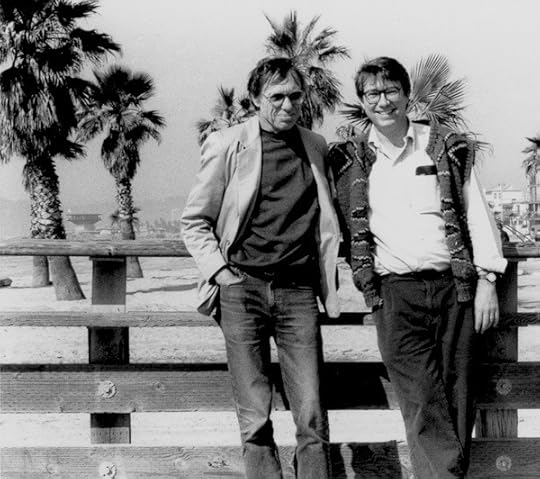
Unrelated photo: Rooting through some old scrapbook-style journals, I came across this picture of me with my SF mentor Robert Sheckley in Venice Beach, CA, around 1987. Bob would be proud of me today.
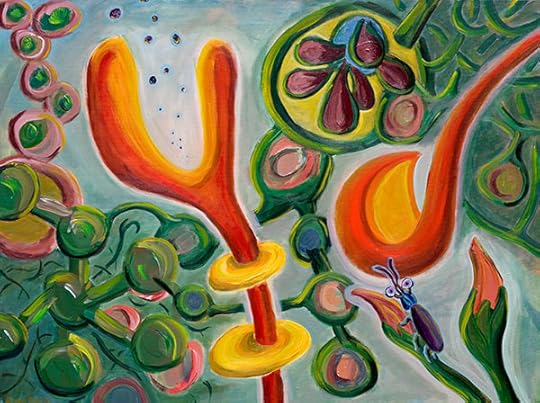
By the way, if you stop by Borderlands, they have a number of large, very high quality, signed color prints of my paintings that I made on heavy archival paper. We're looking to sell a few of these off, so the price is all the way down at $18 a print. Stop by and get one if you're walking by. Another kind of "Emperor Norton money."
September 10, 2011
Tachyon Party at Borderlands
I'm going to be at Borderlands Books in SF for the annual Tachyon Publications party on Sunday from 2-4. One of the events at the party is the awarding of the Emperor Norton Awards. As Locus magazine explains:
The Emperor Norton Awards are a San Francisco Bay area specific award given each year for "extraordinary invention and creativity unhindered by the constraints of paltry reason". The award is named after and commemorates the memory of Joshua Norton I, Emperor of the United States of America and Protector of Mexico, and are presented annually by Tachyon Publications and Borderlands Bookstore in San Francisco.

Unrelated photo: Rooting through some old scrapbook-style journals, I came across this picture of me with my SF mentor Robert Sheckley in Venice Beach, CA, around 1987.
September 6, 2011
Flurb #12
Issue #12 of Flurb is out, with astonishing tales by fifteen writers: Byrne, Callaway, Di Filippo, Ellwood, Gunn, Hayes, Hogan, Moore, Rucker, Salinas, Shirley, Skaftun, Sterling, Tambour, Webb!
This makes five years of Flurb since the first issue, by the way, with 153 stories published thus far.
Go to www.flurb.net and be among the first of the sixty-five thousand people who'll be checking out our new issue over the coming six months!
Seek the gnarl, dear readers, seek the gnarl.
And when you take a break, come back here and post something encouraging in the comments. Our authors need your support.
September 2, 2011
Two Daughters!
I've been away from the blog for the last few weeks because I was on a trip out to Wyoming and Wisconsin to visit our two daughters and their families.
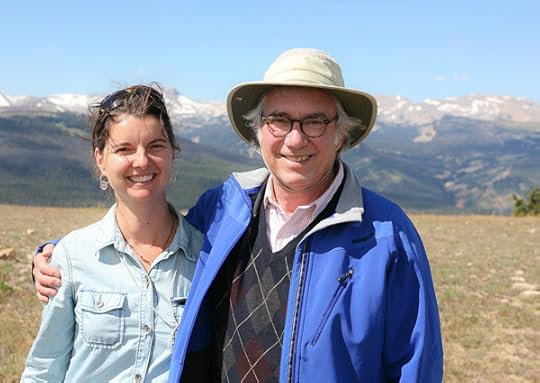
Isabel lives in Wyoming, where she runs her business, Isabel Jewelry, which exists both online and as a storefront in Pindedale, WY.

And Georgia is in Wisconsin, running her business Georgia Rucker Design, where she's mostly designing books these days.
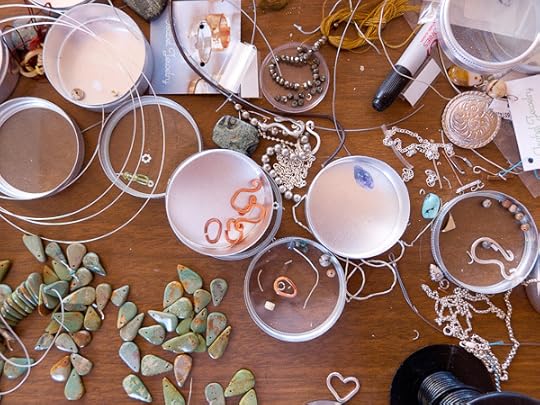
Isabel has accumulated an amazing amount of tools and know-how over the years. It's sort of alchemical, the way she turns bits of stone and metal into adornment. I've always loved cluttered workbenches.
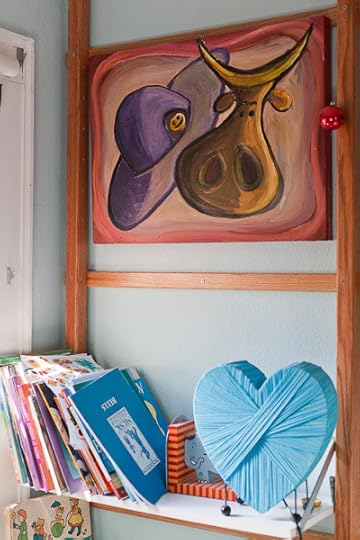
I didn't get any photos of Georgia's office because mostly we were at her house with her husband, Courtney, their two kids, and the kids' toys. I gave my little grandson that "Cow and UFO" painting I was talking about in the previous blog post. He likes it.
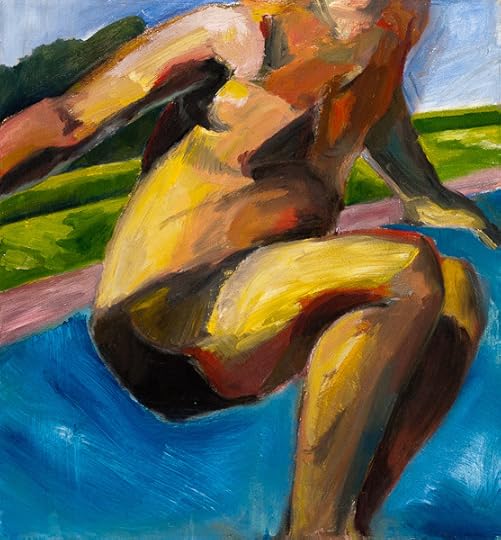
"Jumping Man," (C) Georgia Rucker, about 18 by 24 inches, oil on canvas. Click for a larger version.
I got a photo of a nice, somewhat cubist painting Georgia did of me a few years back—it's based on a photo of, she says, me in mid-air, jumping off something. I get kind of hyper when we go swimming.

"Cloud Spirits II," (C) Isabel Rucker, about 6 feet by 1.5 feet, November, 2010, Latex paint on wood. Click for a large detail view of the picture.
Isabel is a painter too, and, as well as her jewelry, she's been making fairly large paintings of clouds—the one above is called "Cloud Spirits," and is quite awesome.
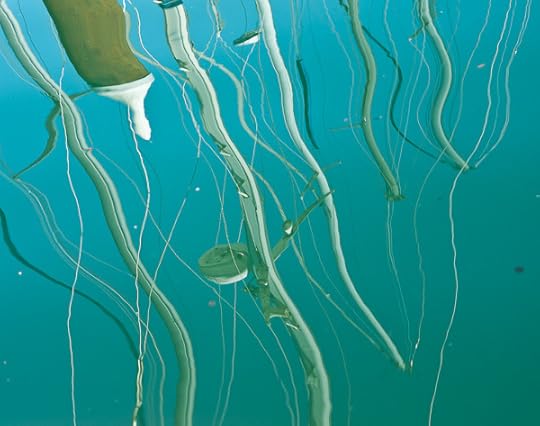
This is a cool picture of a reflection in the Santa Cruz Harbor. I think I'll do a painting from this. I already did a painting of the harbor with a young seal or sea lion, shown below.
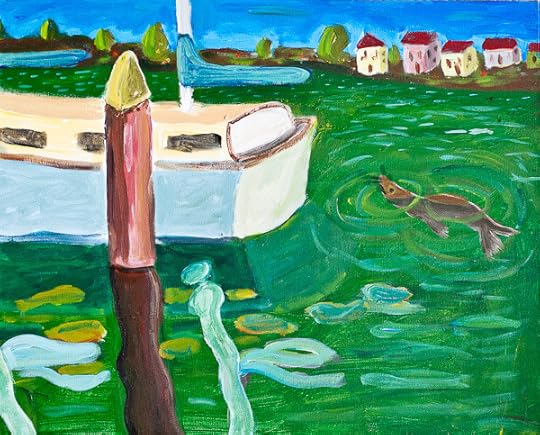
"Santa Cruz Harbor," by Rudy Rucker, 20 x 16 inches, September, 2011, Acrylic on canvas. Click for a larger version of the picture.
Now that I'm back in California, I've been putting together the next issue of my webzine FLURB. It's a doozy. I'll be rolling out the new issue early on Tuesday, September 6, when everyone's back from the beach and at their computers. I'll do a special post announcing it.
Back From Visiting My Daughters
I've been away from the blog for the last few weeks because I was on a trip out to Wyoming and Wisconsin to visit our two daughters and their families.

Isabel lives in Wyoming, where she runs her business, Isabel Jewelry, which exists both online and as a storefront in Pindedale, WY.

And Georgia is in Wisconsin, running her business Georgia Rucker Design, where she's mostly designing books these days.

Here's a picture of Isabel with an acetylene torch at her workbench. She's accumulated an amazing amount of tools and know-how over the years.

It's sort of alchemical, the way she turns bits of stone and metal into adornment. I've always loved cluttered workbenches.

I didn't get any pictures of Georgia at work because mostly we were at her house with her husband, kids, and the kids' toys. Like these two dolls. Georgia's daughter actually got me to start enjoying the music of Taylor Swift! I gave Georgia's son that "Cow and UFO" painting I was talking about in the previous blog post. He likes it.

This is a cool picture of a reflection in the Santa Cruz Harbor. I think I'll do a painting from this.
Now that I'm back in California, I've been putting together the next issue of my webzine FLURB. It's a doozy. I'll be rolling out the issue sometime in the next few days, and I'll do a special post announcing that.
Rudy Rucker's Blog
- Rudy Rucker's profile
- 583 followers






